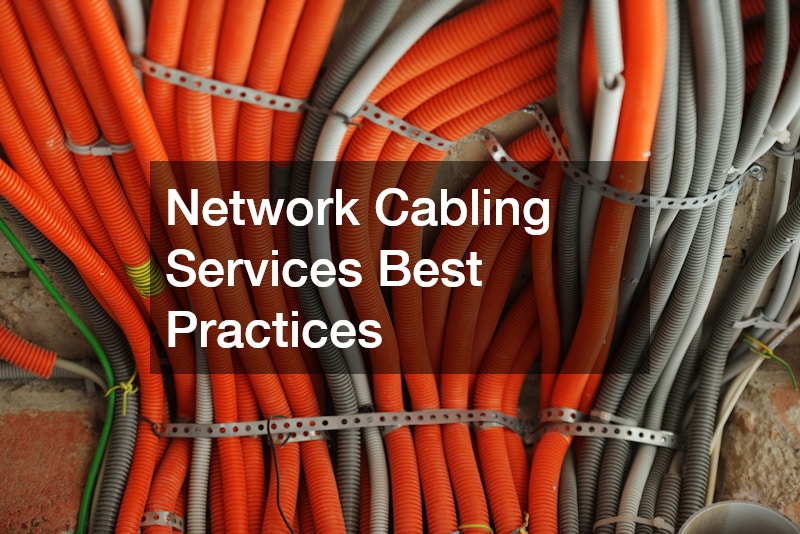In today’s digitally driven world, a reliable network infrastructure is crucial for any business. Network cabling is the backbone of this infrastructure, ensuring seamless internet connectivity and efficient communication within an organization. As we delve into the intricacies of network cabling services, it’s essential to focus on best practices that contribute to sustainable and efficient operations. Whether you’re setting up a new office or upgrading the existing network, understanding these best practices can significantly enhance performance and reduce downtime. Read on to learn about best practices as they relate to network cabling services for homes, businesses, and new developments.
Choosing the Right Cable Type
Firstly, choosing the right type of cable is paramount. Different types of network cables such as Cat5e, Cat6, and fiber optics serve various purposes and have unique benefits.
For instance, while Cat5e cables are adequate for standard applications, Cat6 cables are preferable for higher bandwidth needs. Fiber optic cables offer even higher speeds and reliability over longer distances but come with higher installation costs. Assess your specific requirements, including data traffic, distance, and budget, to select the most appropriate cabling solution. This assessment often requires consulting with experts who offer network cabling services in Pittsburgh, PA, to align the choice with future scalability needs.
Installing With Proper Techniques
Another essential practice is the proper installation technique. Proper cable management during installation can prevent issues like crosstalk, signal interference, and physical damage, which can compromise network performance. Structured cabling solutions, which organize and label cables systematically, facilitate easier troubleshooting and maintenance. Moreover, adhering to industry standards such as ANSI/TIA or ISO/IEC ensures that installations are performed with precision. This attention to detail in installation not only enhances network performance but also extends the lifespan of the cables.
Considering Environmental Factors
Moreover, environmental considerations must not be overlooked. Protecting cables from harsh environmental conditions, such as moisture and extreme temperatures, is crucial. Using appropriate conduits and enclosures can shield cables from damage. Additionally, planning for future growth by installing extra cabling or using intermediary connection points can save on costs and minimize disruptions as your business expands. This forward-thinking approach is essential, especially for businesses in regions prone to environmental extremes, ensuring both resilience and scalability.
Keeping Up With Maintenance and Updates
Regular maintenance and updates represent another cornerstone of network cabling best practices. Periodic inspections help identify wear and tear or potential issues before they result in significant downtime. Keeping abreast of technological advancements and replacing outdated components can optimize network efficiency. Engage experts in the field, such as those providing network cabling services in Pittsburgh, PA, to conduct these evaluations and updates. Doing so ensures that your network infrastructure remains robust and capable of supporting evolving technological demands.
Considering Security Concerns
In addition to maintenance, security considerations are becoming increasingly vital. With the rise in cyber threats, physical network security is often overlooked but equally important. Ensuring that cabling routes and equipment are secured against unauthorized access can prevent tampering and data breaches. Implementing network segmentation and redundancy can further enhance both security and reliability. As businesses handle greater volumes of sensitive data, combining sound cabling practices with cybersecurity measures creates a comprehensive protection strategy.
Continuing With Documentation and Training
Lastly, documentation and training are critical components that often receive inadequate attention. Thorough documentation of the network cabling layout, including maps, the type of cabling used, and troubleshooting records, simplifies future maintenance and upgrades. Additionally, training staff to understand basic network cabling principles can result in more efficient troubleshooting and fewer service interruptions. It’s a proactive strategy that not only empowers your team but also enhances overall operational efficiency.
In conclusion, adhering to network cabling services best practices is a vital step in building a reliable and efficient communication infrastructure. From selecting the right cables and installation method to considering environmental factors, security measures, and planning for future growth, each step contributes to the robustness of your network. Regular maintenance, comprehensive documentation, and staff training ensure long-term sustainability. Leveraging professional expertise, particularly from local services like those in Pittsburgh, PA, can further enhance network integrity and reduce operational risks. As technology continues to evolve, these best practices will serve as a foundational guide to maintaining a competitive edge.
